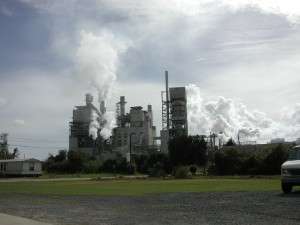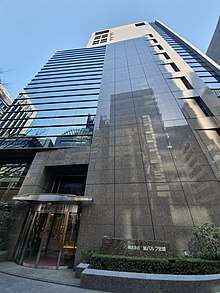Pulp and paper industry
The pulp and paper industry comprises companies that use wood as raw material and produce pulp, paper, paperboard and other cellulose-based products.



The pulp is fed to a paper machine where it is formed as a paper web and the water is removed from it by pressing and drying.
Pressing the sheet removes the water by force. Once the water is forced from the sheet, a special kind of felt, which is not to be confused with the traditional one, is used to collect the water. Whereas, when making paper by hand, a blotter sheet is used instead.
Drying involves using air or heat to remove water from the paper sheets. In the earliest days of paper making, this was done by hanging the sheets like laundry. In more modern times, various forms of heated drying mechanisms are used. On the paper machine, the most common is the steam heated can dryer.
Pulp
History of the paper industry
The commercial planting of domesticated mulberry trees to make pulp for papermaking is attested as early as the 6th century.[1] Due to advances in printing technology, the Chinese paper industry continued to grow under the Song dynasty to meet the rising demand for printed books. Demand for paper was also stimulated by the Song government, which needed a large supply of paper for printing paper money and exchange certificates.[2] The first mechanised paper machine was installed at Frogmore Paper Mill, Apsley, Hertfordshire in 1803, followed by another in 1804.[3] The site operates currently as a museum.[4]
Environmental effects
The pulp and paper industry has been criticized by environmental groups like the Natural Resources Defense Council for unsustainable deforestation and clearcutting of old-growth forest.[5] The industry trend is to expand globally to countries like Russia, China and Indonesia with low wages and low environmental oversight.[6] According to Greenpeace, farmers in Central America illegally rip up vast tracts of native forest for cattle and soybean production without any consequences,[7] and companies who buy timber from private land owners contribute to massive deforestation of the Amazon Rainforest.[8] On the other hand, the situation is quite different where forest growth has been on the increase for a number of years. It is estimated for instance that since 1990 forests have grown in Europe by a size equivalent to that of Switzerland (44,160 KM) which has been supported through the practice of sustainable forest management by the industry. In Sweden, for every tree that is felled, two are planted.[9]
The pulp and paper industry consumes a significant amount of water and energy and produces wastewater with a high concentration of chemical oxygen demand (COD); recent studies underline as an appropriate pre-treatment of the wastewater (e.g. the coagulation) is cost-effective solution for the removal of COD and the reduction of the pressures on the aquatic environment.[10]
Use of surfactants and anthraquinone have reduced alkali consumption in Pulp Cooking and use of Xylanase enzymes in bleaching operation is effective to decreasing AOX discharges in Pulp mill effluent.
Current production volumes and sales
The industry is dominated by North American (United States and Canada), northern European (Finland, Sweden, and North-West Russia) and East Asian countries (such as East Siberian Russia, China, Japan, and South Korea). Australasia and Brazil also have significant pulp and paper enterprises. The industry also has a significant presence in a number of European countries including Germany, Portugal, Italy, the Netherlands and Poland. The United States had been the world's leading producer of paper until it was overtaken by China in 2009.[11]
List of main countries by production quantity
According to statistic data by RISI, main producing countries of paper and paperboard, not including pulp, in the world are as follows:[12]
| Rank 2011 | Country | Production in 2011 (1,000 ton) | Share 2011 | Rank 2010 | Production in 2010 (1,000 ton) |
|---|---|---|---|---|---|
| 1 | 99,300 | 24.9% | 1 | 92,599 | |
| 2 | 75,083 | 18.8% | 2 | 75,849 | |
| 3 | 26,627 | 6.7% | 3 | 27,288 | |
| 4 | 22,698 | 5.7% | 4 | 23,122 | |
| 5 | 12,112 | 3.0% | 5 | 12,787 | |
| 6 | 11,492 | 2.9% | 8 | 11,120 | |
| 7 | 11,329 | 2.8% | 6 | 11,789 | |
| 8 | 11,298 | 2.8% | 7 | 11,410 | |
| 9 | 10,159 | 2.5% | 10 | 9,796 | |
| 10 | 10,035 | 2.5% | 9 | 9,951 | |
| World Total | 398,975 | 100.0% | 394,244 |
List of main company groups by production quantity
The world's main paper and paperboard company groups are as follows. (Some figures are estimates.):[13]
| Rank | Company Group | Country | Production in 2015 (1,000 ton) | Rank by Sales |
|---|---|---|---|---|
| 1 | International Paper | 23315 | 1 | |
| 2 | Nine Dragon Paper Holdings | 12630 | 18 | |
| 3 | WestRock | 12487 | 4 | |
| 4 | UPM | 9771 | 5 | |
| 5 | Stora Enso | 9188 | 8 | |
| 6 | Oji Paper Company | 9115 | 3 | |
| 7 | Sappi | 7306 | 15 | |
| 8 | Smurfit Kappa | 7000 | 9 | |
| 9 | DS Smith | 6802 | 13 | |
| 10 | Nippon Paper | 6542 | 11 | |
List by net sales
In 2008, the top 10 forest, paper and packaging products companies were, according to a report by PricewaterhouseCoopers:[14]
| Rank | Company | Country | 2008 Net Sales (US$M) | 2008 Net Income (Loss) (US$M) |
|---|---|---|---|---|
| 1 | International Paper | 24,829 | (1,282) | |
| 2 | Kimberly-Clark | 19,415 | 1,690 | |
| 3 | SCA | 16,965 (SEK) | 857 | |
| 4 | Stora Enso | 16,227 | (991) | |
| 5 | UPM | 13,920 | (263) | |
| 6 | Oji Paper | 12,788 | 114 | |
| 7 | Nippon Unipac | 11,753 | 55 | |
| 8 | Smurfit Kappa | 10,390 | (73) | |
| 9 | Metsä Group | 9,335 | (313) | |
| 10 | Mondi Group | 9,466 | (310) | |
Manufacturers and suppliers for the industry

Leading manufacturers of capital equipment with over $1 billion in annual revenue for the pulp and paper industry include:
See also
References
- Tsien, Tsuen-Hsuin (1985), Paper and Printing, Science and Civilisation in China: Chemistry and Chemical Technology, Vol. 5 Part 1, Cambridge University Press, p. 58
- Tsien, Tsuen-Hsuin (1985), Paper and Printing, Science and Civilisation in China: Chemistry and Chemical Technology, Vol. 5 Part 1, Cambridge University Press, p. 48
- Hills, Richard, "Papermaking in Britain 1488–1988", Athlone Press, 1988.
- "The Paper Trail at Frogmore Mill". Apsley Paper Trail charity. Retrieved 2 February 2017.
- "NRDC: Paper Industry Laying Waste to North American Forests". www.nrdc.org. Retrieved 19 February 2016.
- "A crumpling paper industry". Oregon Local News. Retrieved 19 February 2016.
- "Amazon draught speeds up destruction The WE News Archives". www.thewe.cc. Archived from the original on 25 December 2016. Retrieved 19 February 2016.
- Phillips, Tom (20 May 2011). "Brazil forms 'crisis cabinet' following unexpected deforestation surge". The Guardian. ISSN 0261-3077. Retrieved 19 February 2016.
- "Will the EU turn the tide on forest growth and torpedo its bioeconomy agenda?". euractiv.com.
- Boguniewicz-Zablocka, Joanna; Klosok-Bazan, Iwona; Naddeo, Vincenzo; Mozejko, Clara A. (2019-09-26). "Cost-effective removal of COD in the pre-treatment of wastewater from the paper industry". Water Science and Technology: wst2019328. doi:10.2166/wst.2019.328. ISSN 0273-1223.
- De Sisti, Mike (12 December 2012). "China's Paper Operation". Pulitzer Center on Crisis Reporting. Retrieved 13 April 2013.
- "Japan in the World (according to the figure in Annual Review of Global Pulp and Paper Statistics by RISI)" (in Japanese). Japan Paper Association. Retrieved 15 November 2012.
- "The PPI Top 100". RISI. Retrieved 2 February 2017.
- "Global Forest, Paper & Packaging Industry Survey: 2009 Edition - Survey of 2008 Results" (pdf). PricewaterhouseCoopers. p. 12. Retrieved 24 February 2011.